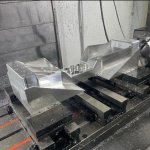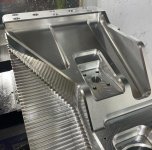From my understanding, Hypermill does not use MW. They do, however, license and use Volumill.
My experience with Camworks is much different than Marvel's. I had a super feature heavy part that drove me insane due to calculation times taking forever when roughing with Volumill. If you watch the message window, it would generate a faceted model(STL) of the part body for every toolpath which is not ideal. Obviously, if your toolpath accuracy is set high, time will increase dramatically. But the faceting stage, whether or not it is apparent to the user, does happen which is how they can calculate toolpaths in the first place. 3D printer Slicing software use STLs natively for this very reason; calculating toolpaths.
Another part we had that was super tiny, but relatively simple in geometry, took overnight to calculate a volumill path in camworks. I used this part, among others, when I did a CAM evaluation to see if it was worth changing systems entirely. Mastercam was about ~40 mins, Hypermill was about ~10 min, and CamTool was ~1 min. All using the CAM system's respective volumill/dynamic roughing. Same ae/ap, tool info, toolpath resolution, etc..
While MW does make a toolpath just fine, the implementation of it does matter.
I'm super happy that Marvel has had great results. We never did.
And as others have pointed out, while having a decent computer does speed things up, the linear processing of 1 path before the next will probably the norm until a new technology comes to fruition.
just my2c







 . Depends what you are trying to do and what 5 axis work you are doing. Difficult to say how it compare with the other without comparing like for like. If you post a part with an idea of a toolpath that's needed I can throw something at it and see what it gives.
. Depends what you are trying to do and what 5 axis work you are doing. Difficult to say how it compare with the other without comparing like for like. If you post a part with an idea of a toolpath that's needed I can throw something at it and see what it gives.